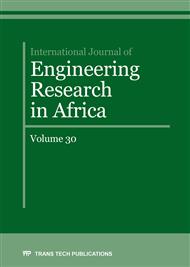[1]
C.S. Sasikumar, and T. Papinazeth, Environmental management: bioremediation of polluted environment, Proceedings of the Third International Conference on Environmental and health, Chennai, India, (2003) 456-469.
Google Scholar
[2]
A.P. Mariano, A.P. Kataoka, D. Angelis, and D.M.A. Bonotto, Laboratory study on the bioremediation of diesel oil contamination soil from a petrol station, Brazilian Journal of Microbiology, 38 (2007) 346-351.
DOI: 10.1590/s1517-83822007000200030
Google Scholar
[3]
A.A. Ibiene, F.A. Orji, C.O. Ezidi, and C.L. Ngwobia, Bioremediation of hydrocarbon contaminated soil in the Niger Delta using spent mushroom compost and other organic wastes, Nigerian Journal of Agriculture, Food and Environment, 7(3) (2011) 1-7.
Google Scholar
[4]
A.S.S. Tahseen, Bioremediation of polycyclic aromatic hydrocarbons (PAHs)-contaminated soil: process evaluation through composting and anaerobic digestion approach, PhD Thesis, Chemical Engineering Department, Universatat Autonoma de Barcelona, (2010).
Google Scholar
[5]
P.V.O. Trindade, L.G. Sobral, A.C.L. Rizzo, S.G.F. Leite, and A.U. Seriano, Bioremediation of a weathered and a recently oil-contaminated soil from Brazil: a comparison study, Chemosphere, 58 (2005) 515-522.
DOI: 10.1016/j.chemosphere.2004.09.021
Google Scholar
[6]
N.U. Udeh, I.L. Nwaogazie and Y. Momoh, Bio-remediation of a crude oil contaminated soil using water hyacinth (Eichhornia crassipes), Advances in Applied Science Research, 4(2) (2013) 362-369.
Google Scholar
[7]
V.C. Eze, and G.C. Okpokwasili, Microbial and other related changes in a Niger Delta River sediment receiving industrial effluents, Continental Journal of Microbiology, 4 (2010) 15-21.
Google Scholar
[8]
V.S. Millioli, E.L.C. Servulo, L.G.S. Sobral, W. Declor, and D.E. Iho, Bioremediation of crude of bearing soil: Evaluating the effect of Rhamnnolipid addition to soil toxicity and to crude oil biodegradation efficiency, Global Nest Journal, 11(2) (2009).
DOI: 10.30955/gnj.000592
Google Scholar
[9]
J.A. Marin, T. Hernandez, and C. Garcia, Bioremediation of oil refinery sludge by land farming in semiarid conditions: influence on soil microbial activity, Environmental Research, 98(2) (2005) 185-195.
DOI: 10.1016/j.envres.2004.06.005
Google Scholar
[10]
L. Leitgib, K. Gruiz, E. Fenyvesi, G. Balogh, and A. Muranyi, Development of an innovative soil remediation: Cyclodextrin-enhanced combined technology, Science Total Environment, 392(1) (2008) 12-21.
DOI: 10.1016/j.scitotenv.2007.10.055
Google Scholar
[11]
A.I. Okoh, and M.R. Trejo-Hernandez, Remediation of petroleum hydrocarbon polluted systems: exploiting the bioremediation strategies, African Journal of Biotechnology, 5(25) (2006) 2520-2525.
Google Scholar
[12]
F. Benyahia, M. Abdulkarim, A. Zekri, O. Chaalal, and H. Hasanain, Bioremediation of crude oil contaminated soils: A Black Art or an Engineering Challenge? Process Safety and Environmental Protection, 83(B4) (2005) 364-370.
DOI: 10.1205/psep.04388
Google Scholar
[13]
S.E. Agarry, and L. Jimoda, Application of carbon-nitrogen supplementation from plant and animal sources in in-situ soil bioremediation of diesel oil: experimental analysis and kinetic modelling, Journal of Environment and Earth Science, 3(7) (2013).
Google Scholar


